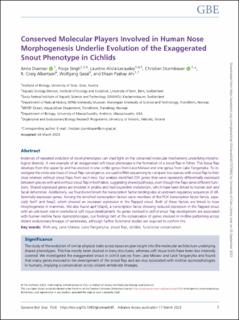| dc.contributor.author | Duenser, Anna | |
| dc.contributor.author | Singh, Pooja | |
| dc.contributor.author | Lecaudey, Laurène Alicia | |
| dc.contributor.author | Sturmbauer, Christian | |
| dc.contributor.author | Albertson, R. Craig | |
| dc.contributor.author | Gessl, Wolfgang | |
| dc.contributor.author | Ahi, Ehsan Pashay | |
| dc.date.accessioned | 2023-10-20T11:30:17Z | |
| dc.date.available | 2023-10-20T11:30:17Z | |
| dc.date.created | 2023-03-21T09:55:54Z | |
| dc.date.issued | 2023 | |
| dc.identifier.citation | Genome Biology and Evolution. 2023, 15, 4, evad045 | en_US |
| dc.identifier.issn | 1759-6653 | |
| dc.identifier.uri | https://hdl.handle.net/11250/3097784 | |
| dc.description.abstract | Instances of repeated evolution of novel phenotypes can shed light on the conserved molecular mechanisms underlying morphological diversity. A rare example of an exaggerated soft tissue phenotype is the formation of a snout flap in fishes. This tissue flap develops from the upper lip and has evolved in one cichlid genus from Lake Malawi and one genus from Lake Tanganyika. To investigate the molecular basis of snout flap convergence, we used mRNA sequencing to compare two species with snout flap to their close relatives without snout flaps from each lake. Our analysis identified 201 genes that were repeatedly differentially expressed between species with and without snout flap in both lakes, suggesting shared pathways, even though the flaps serve different functions. Shared expressed genes are involved in proline and hydroxyproline metabolism, which have been linked to human skin and facial deformities. Additionally, we found enrichment for transcription factor binding sites at upstream regulatory sequences of differentially expressed genes. Among the enriched transcription factors were members of the FOX transcription factor family, especially foxf1 and foxa2, which showed an increased expression in the flapped snout. Both of these factors are linked to nose morphogenesis in mammals. We also found ap4 (tfap4), a transcription factor showing reduced expression in the flapped snout with an unknown role in craniofacial soft tissue development. As genes involved in cichlid snout flap development are associated with human mid-line facial dysmorphologies, our findings could hint at the conservation of genes involved in mid-line patterning across distant evolutionary lineages of vertebrates, although further functional studies are required to confirm this. | en_US |
| dc.language.iso | eng | en_US |
| dc.publisher | Oxford University Press | en_US |
| dc.rights | Navngivelse 4.0 Internasjonal | * |
| dc.rights.uri | http://creativecommons.org/licenses/by/4.0/deed.no | * |
| dc.title | Conserved Molecular Players Involved in Human Nose Morphogenesis Underlie Evolution of the Exaggerated Snout Phenotype in Cichlids | en_US |
| dc.title.alternative | Conserved Molecular Players Involved in Human Nose Morphogenesis Underlie Evolution of the Exaggerated Snout Phenotype in Cichlids | en_US |
| dc.type | Peer reviewed | en_US |
| dc.type | Journal article | en_US |
| dc.description.version | publishedVersion | en_US |
| dc.rights.holder | © The Author(s) 2023. Published by Oxford University Press on behalf of Society for Molecular Biology and Evolution. | en_US |
| dc.source.volume | 15 | en_US |
| dc.source.journal | Genome Biology and Evolution (GBE) | en_US |
| dc.source.issue | 4 | en_US |
| dc.identifier.doi | 10.1093/gbe/evad045 | |
| dc.identifier.cristin | 2135604 | |
| dc.source.articlenumber | evad045 | en_US |
| cristin.ispublished | true | |
| cristin.fulltext | original | |
| cristin.qualitycode | 2 | |

